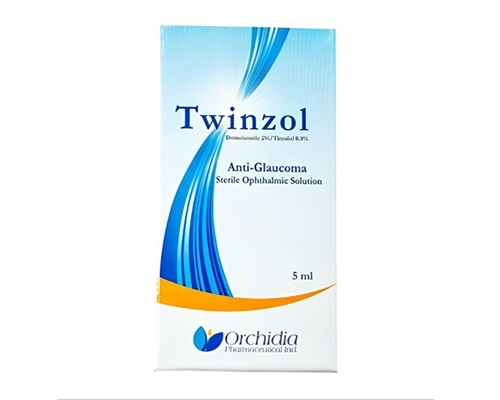Description
Trade name:
Twinzol
Compound:
Each ml of drops contains:
Dorzolamide hydrochloride 22.26 mg, which corresponds to a content of dorzolamide 20 mg
Timolol maleate 6.83 mg, which corresponds to a content of timolol 5 mg.
Excipients: benzalkonium chloride.
Properties:
Antiglaucoma drug of combined composition. Contains two active components: dorzolamide hydrochloride and timolol maleate, each of which reduces increased intraocular pressure by reducing the secretion of intraocular fluid. The combined action of these substances in the drug leads to a more pronounced decrease in intraocular pressure.
Dorzolamide hydrochloride is a selective inhibitor of carbonic anhydrase type II. Inhibition of carbonic anhydrase in the ciliary body results in decreased secretion of aqueous humor, presumably by reducing the formation of bicarbonate ions, which in turn slows down the transport of sodium and fluid.
Timolol maleate is a non-selective beta-blocker. Although the exact mechanism of action of timolol maleate in reducing intraocular pressure has not yet been established, several studies have shown a predominant reduction in formation and a slight increase in fluid outflow.
Indications:
Increased intraocular pressure:
for open-angle glaucoma;
in pseudoexfoliative glaucoma when monotherapy is insufficiently effective.
Method of administration and dosage:
Twinzol is prescribed 1 drop in the conjunctival sac of the affected eye (or both eyes) 2 times a day.
If Twinzol is prescribed as a replacement for another ophthalmic drug for the treatment of glaucoma, the latter should be discontinued the day before starting Twinzol therapy.
When used in combination with another topical ophthalmic drug, Twinzol should be administered at least 10 minutes apart.
With nasolacrimal occlusion (closing the eyelids) for 2 minutes after instillation of the drug, its systemic absorption decreases, which can lead to an increase in local action.
Contraindications:
Airway hyperreactivity;
bronchial asthma (including history);
severe COPD;
sinus bradycardia;
SSSU;
AV block II and III degree without a pacemaker;
severe heart failure;
cardiogenic shock;
severe renal failure (CC <30 ml/min);
hyperchloremic acidosis;
dystrophic processes in the cornea;
pregnancy;
lactation period (breastfeeding);
children and adolescents under 18 years of age (due to insufficient study of efficacy and safety);
hypersensitivity to the components of the drug.
Precautions:
Like other ophthalmic drugs used topically, Twinzol can be absorbed into the systemic circulation. Since timolol, which is part of the drug, is a beta-blocker, adverse reactions that develop with systemic use of beta-blockers may be observed with local application of the drug.
If the first signs or symptoms of heart failure appear, the use of Twinzol should be discontinued.
Discontinuation of treatment:
If it is necessary to discontinue topical timolol, as with systemic beta-blockers, discontinuation of therapy in patients with coronary artery disease should be gradual.
Corneal disorders:
Beta-blockers used in ophthalmology can cause dry eye. The drug should be administered with caution to patients with corneal disorders. Patients with low endothelial cell counts have an increased risk of developing corneal edema.
Using contact lenses:
Twinzol contains the preservative benzalkonium chloride, which may cause eye irritation. Before using the drug, lenses must be removed and reinserted no earlier than 15 minutes after instillation of the drug. Benzalkonium chloride can discolor soft contact lenses.
Impact on the ability to drive vehicles and operate machinery:
When using Twinzol, side effects may develop, which in some patients may make it difficult to drive a car or operate complex machinery.
Side effects:
The most frequently observed side effects were visual: burning or itching in the eye, taste distortion, corneal erosions, conjunctival injections, blurred vision, lacrimation.
Below are the possible side effects of the components of the drug.
Dorzolamide hydrochloride:
From the organ of vision: inflammation of the eyelid, irritation and peeling of the eyelid, iridocyclitis, punctate keratitis, transient myopia (passing after discontinuation of the drug).
From the nervous system: headache, dizziness, paresthesia.
Allergic reactions: angioedema, bronchospasm, itching, urticaria.
Others: asthenia/fatigue, nosebleed, throat irritation, dry mouth, rash.
Timolol maleate:
From the organ of vision: conjunctivitis, blepharitis, keratitis, decreased sensitivity of the cornea, dryness; visual disturbances, including changes in the refractive power of the eye (in some cases due to the withdrawal of miotics), diplopia, ptosis.
From the cardiovascular system: arrhythmia, hypotension, fainting, cardiovascular disorders, rhythm disturbances, cardiac arrest, edema, paresthesia, Raynaud’s phenomenon.
From the respiratory system: bronchospasm, cough.
Dermatological reactions: alopecia, psoriasis-like rashes or exacerbation of psoriasis.
Allergic reactions: anaphylaxis, angioedema, urticaria, local or generalized rash.
From the nervous system: headache, dizziness; paresthesia, depression, insomnia, nightmares, memory loss, worsening of myasthenia symptoms.
From the digestive system: diarrhea, dyspepsia, dry mouth.
Others: tinnitus, asthenia, fatigue, chest pain, abdominal pain, decreased libido, Peyronie’s disease, sexual dysfunction, systemic lupus erythematosus, myalgia, lameness, decreased temperature of the hands and feet, edema.
Storage method:
Store in a dry, dark place at a temperature of 15 to 30 degrees. Do not use more than 30 days after opening.
Package:
The cardboard box contains a 5 ml plastic dropper bottle and paper instructions.









